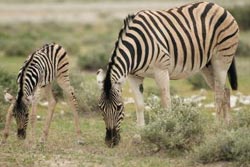New, unusually large virus kills anthrax agent

This shows zebras graze in Etosha National Park, Namibia. Zebras can fall victim to anthrax. The new bacteriophage virus called Tsamsa, isolated from zebra carcasses in the park, kills the anthrax bacterium.<br><br>Credit: Holly Ganz, UC Davis.<br>
The novel bacteriophage could eventually open up new ways to detect, treat or decontaminate the anthrax bacillus and its relatives that cause food poisoning. The work is published Jan. 27 in the journal PLOS One.
The virus was isolated from samples collected from carcasses of zebras that died of anthrax in Etosha National Park, Namibia. The anthrax bacterium, Bacillus anthracis, forms spores that survive in soil for long periods. Zebras are infected when they pick up the spores while grazing; the bacteria multiply and when the animal dies, they form spores that return to the soil as the carcass decomposes.
While anthrax is caused by a bacterium that invades and kills its animal host, bacteriophages, literally “bacteria eaters” are viruses that invade and kill bacterial hosts.
The first thing the team noticed was that the virus was a voracious predator of the anthrax bacterium, said Holly Ganz, a research scientist at the University of California, Davis Genome Center and first author on the paper.
They also noticed that the new virus, named Bacillus phage Tsamsa, is unusually large, with a giant head, a long tail and a large genome, placing it among the largest known bacteriophages.
Tsamsa infects not only B. anthracis but also some closely related bacteria, including strains of Bacillus cereus, which can cause food poisoning. Sequencing the genome allowed researchers to identify the gene for lysin, an enzyme that the virus uses to kill bacterial cells, that has potential use as an antibiotic or disinfecting agent.
Bacteriophages are often highly specific to a particular strain of bacteria, and when they were first discovered in the early 20th century there was strong interest in them as antimicrobial agents. But the discovery of penicillin and other antibiotics eclipsed phage treatments in the West, although research continued in the Soviet Union.
“With growing concerns about antibiotic resistance and superbugs, people are coming back to look at phages,” said Ganz said.
One advantage of bacteriophages is that because they tend to be very specific, they can potentially target only “bad” bacteria while leaving beneficial bacteria unharmed.
Ganz began the work as a postdoctoral scientist on a team led by Wayne Getz, Professor of Environmental Science, Policy and Management at UC Berkeley and at the University of KwaZulu-Natal, South Africa. Sequencing of the phage genome was conducted at UC Davis after Ganz joined the laboratory of Professor Jonathan Eisen.
Ganz said that she hoped the publication of the phage's sequence information would enable other researchers to investigate further and potentially develop applications for the phage and its proteins.
“You might use it to detect the anthrax Bacillus or B. cereus; use it as an alternative to antibiotics or as part of a decontaminant,” she said.
Other authors on the study are: Wayne Getz, Christina Law and Richard Calendar, UC Berkeley; Martina Schmuki, Fritz Eichenseher, Martin Loessner and Jochen Klumpp at the Institute of Food, Nutrition and Health, ETH Zurich, Switzerland; Jonas Korlach, Pacific Biosciences, Menlo Park, Calif.; and Wolfgang Beyer, University of Hohenheim, Stuttgart, Germany. The work was supported by the NIH.
Media Contact
More Information:
http://www.ucdavis.eduAll latest news from the category: Life Sciences and Chemistry
Articles and reports from the Life Sciences and chemistry area deal with applied and basic research into modern biology, chemistry and human medicine.
Valuable information can be found on a range of life sciences fields including bacteriology, biochemistry, bionics, bioinformatics, biophysics, biotechnology, genetics, geobotany, human biology, marine biology, microbiology, molecular biology, cellular biology, zoology, bioinorganic chemistry, microchemistry and environmental chemistry.
Newest articles

“Nanostitches” enable lighter and tougher composite materials
In research that may lead to next-generation airplanes and spacecraft, MIT engineers used carbon nanotubes to prevent cracking in multilayered composites. To save on fuel and reduce aircraft emissions, engineers…

Trash to treasure
Researchers turn metal waste into catalyst for hydrogen. Scientists have found a way to transform metal waste into a highly efficient catalyst to make hydrogen from water, a discovery that…

Real-time detection of infectious disease viruses
… by searching for molecular fingerprinting. A research team consisting of Professor Kyoung-Duck Park and Taeyoung Moon and Huitae Joo, PhD candidates, from the Department of Physics at Pohang University…





















